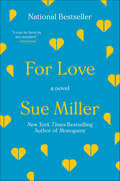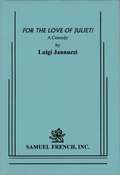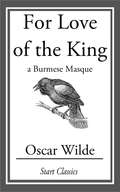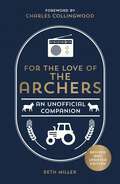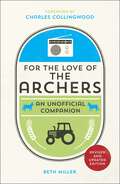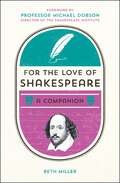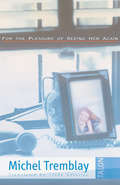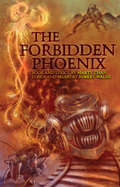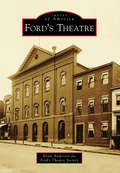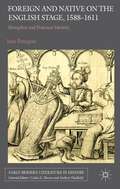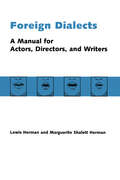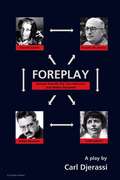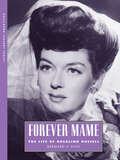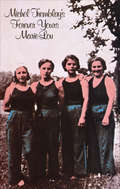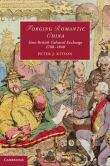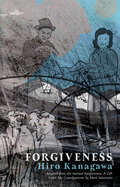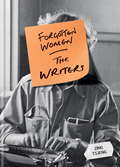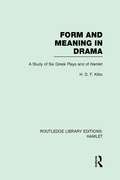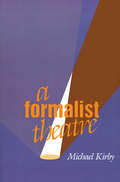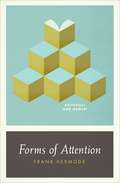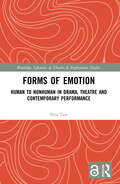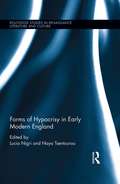- Table View
- List View
For Love: A Novel
by Sue Miller"A tour de force by any standard." —Newsweek"Miller writes with wisdom, compassion, and an almost palpable sense of reality about the ambiguous and difficult choices that . . . at one time or another, life demands of us." —Atlanta Journal-ConstitutionA convergence of family and friends stirs memories of the past in New York Times bestselling author Sue Miller's novel about the beautiful, raging, and tragic yearning for romantic love.After years of lives lived apart, Lottie Gardner, her brother, Cameron, and their old friend Elizabeth reunite in their hometown of Cambridge, Massachusetts. Lottie has arrived to settle the estate of her elderly mother in decline. It's also a chance to slip away from a passionless marriage in jeopardy. What she longs for is the kind of heedless romance she sees in her brother's rekindled fling with his childhood sweetheart. But Elizabeth is in the throes of a marital crisis of her own. And when blind desire culminates in a senseless tragedy, Lottie, Cameron, and Elizabeth must confront the choices they've made for love. Gripping, emotional, and unexpected, For Love explores the inevitable reconciliation of the life you dream of when young and hopeful with the reality of the one you must abide.
For The Love Of Juliet
by Luigi JannuzziComedy / 2m, 2f / Interior / Here is a whimsical romantic comedy by the popular author of Night of the Foolish Moon , A Bench at the Edge, and other plays. Julie has dedicated herself to a muse named Romeo who is grooming Julie for a Broadway debut. Alex, the irresponsible love of Julie’s life returns from a five year voyage to find himself and now he wants to recapture Julie’s heart. Will Julie choose the imaginary man or the real man? And are imaginary men more helpful and fun?
For Love of the King: A Burmese Masque
by Oscar WildeThe very interesting and richly coloured masque or pantomimic play which is here printed in book form for the first time, was invented sometime in 1894 or possibly a little earlier. It was written, not for publication, but as a personal gift to the author's friend and friend of his family, Mrs. Chan Toon.
For the Love of The Archers: An Unofficial Companion: Revised and Updated
by Beth Miller Charles CollingwoodA revised and updated edition of the bestselling guide to all things Ambridge, For the Love of the Archers contains extensive all-new content that will keep any fan of the show enlightened and entertained.It’s been over 70 years since the familiar dum-di-dum-didum-di-dum of “Barwick Green” first brought The Archers to our airwaves, and in that time millions of listeners have followed the everyday lives of country folk in Ambridge.Bringing together a wealth of fascinating facts, amusing insights and expert trivia about characters, controversies and country customs in one handy volume – now fully revised and updated to include recent developments – this companion is the perfect gift for avid addicts and keen newcomers alike.Long-time Archers super-fan Beth Miller will be your highly engaging guide to every aspect of radio’s most enduring drama, including the following recurring features:Welcome to Ambridge takes you on a tour of all the key locationsMeet the Characters profiles all your favourite personalitiesMemorable Moments celebrates some of the most entertaining and emotional episodesGone But Not Forgotten remembers the dearly departedQuiz Night at the Bull tests your knowledge of the programme at regular intervalsFor all this and much more, dive into this incredible miscellany and become a true Ambridge expert.
For the Love of The Archers: An Unofficial Companion
by Beth Miller Charles CollingwoodThe bestselling guide to all things Ambridge is back Bringing together a wealth of fascinating facts, amusing insights and expert trivia about characters, controversies and country customs – now fully revised and updated to include recent developments – this unofficial companion is the perfect gift for avid addicts and keen newcomers alike.
For the Love of The Archers: An Unofficial Companion
by Beth Miller Charles CollingwoodThe bestselling guide to all things Ambridge is back Bringing together a wealth of fascinating facts, amusing insights and expert trivia about characters, controversies and country customs – now fully revised and updated to include recent developments – this unofficial companion is the perfect gift for avid addicts and keen newcomers alike.
For the Love of Shakespeare: A Companion
by Beth MillerThere’s never been a better time to take a fresh look at William Shakespeare’s eternal works. His plays and poems continue to surprise, inspire, console and delight us. Whether you’re a lifelong lover of the Bard or a curious newcomer to his world, this companion will lift the curtain on Britain’s greatest dramatist.
For the Love of Shakespeare: A Companion
by Beth MillerThere’s never been a better time to take a fresh look at William Shakespeare’s eternal works. His plays and poems continue to surprise, inspire, console and delight us. Whether you’re a lifelong lover of the Bard or a curious newcomer to his world, this companion will lift the curtain on Britain’s greatest dramatist.
For the Pleasure of Seeing Her Again
by Michel Tremblay Linda GaboriauFor the Pleasure of Seeing Her Again is Tremblay's homage to his mother, who nurtured his imagination, his reclusive reading habits and his love for the theatre and the arts, yet who did not live to witness the performance of Les Belles Soeurs-the first successful play written in joual with which Tremblay legitimized the Quebecois vernacular in the arts-and the world-wide acclaim for her son's artistic genius. In a compelling balance of humour and poignancy, Tremblay offers glimpses of himself and his mother at five different stages of their lives together, culminating in his reassurance of his dying mother's concern for him immediately prior to his spectacular success.
The Forbidden Phoenix
by Marty Chan Robert Walsh Derek MahSun Wukong's path, however, becomes a test of strength, agility, and character as he comes face to face with mysterious, enchanting, and heartless creatures. Inspired by the Chinese opera, The Forbidden Phoenix's lyricism brings us to a world where Chinese parables are woven with the painful history of the immigrant men who suffered greatly to build Canada's railroad in the 1800s. Playwright Marty Chan and composer Robert Walsh create a musical rife with stylized characters, lending itself to a performance brimming with acrobatics, slapstick, and martial arts.
Ford's Theatre (Images of America)
by Brian Anderson Ford's Theatre SocietyFord's Theatre in downtown Washington, DC, is best known as the scene of Pres. Abraham Lincoln's assassination on April 14, 1865. It is among the oldest and most visited sites of national tragedy in the United States. First constructed in 1833 as a Baptist church, the property was acquired by John T. Ford and converted into a theater in 1861. Presenting almost 500 performances before the assassination, Ford afterward sold the building to the federal government. A century later, the National Park Service reconstructed the theater, and Ford's Theatre Society began presenting live performances there in 1968. Since then, the two organizations have partnered to offer more than 650,000 annual visitors an array of quality programming about Lincoln's presidency and legacy. Today, patrons can explore the Tenth Street "campus," consisting of the theater, interactive museum galleries, the house where Lincoln died, and the Center for Education and Leadership.
Foreign and Native on the English Stage, 1588-1611
by Jane PettegreeThis original and scholarly work uses three detailed case studies of plays - Shakespeare's Antony and Cleopatra , King Lear and Cymbeline - to cast light on the ways in which early modern writers used metaphor to explore how identities emerge from the interaction of competing regional and spiritual topographies.
Foreign Dialects: A Manual for Actors, Directors, and Writers
by Lewis Herman Marquerite Shalett HermanMost actors and directors have struggled with the problem of needing to imitate foreign dialects. Marguerite and Lewis Herman have created an essential tool for actors, directors and writers aiming toward the most authentic performances possible.Foreign Dialects contains an extensive repertoire of dialects that will assist the actor in the preparation for the most difficult foreign roles. Now in paperback, this classic text offers the director or producer a quick, convenient aid for correcting actors and evaluating applicants for authenticity and dialect ability. In addition, it guides those writing fiction as well as radio, movie, and television scripts. Thirty foreign dialects are provided, with character studies, speech peculiarities, and examples of the dialects in easy-to-read phonetic monologues--including Cockney, British, Irish, Scottish, French, German, Spanish, Swedish, Polish, Greek and Yiddish.
Foreplay
by Carl DjerassiHannah Arendt, Walter Benjamin, and Theodor W. Adorno were intellectual giants of the first half of the twentieth century. The dramaForeplayexplores their deeply human and psychologically intriguing private lives, focusing on professional and personal jealousies, the mutual dislike of Theodor Adorno and Hannah Arendt, the association between Walter Benjamin and Georges Bataille, and the border between erotica and pornography. Djerassi's extensive biographical research brings to light many fascinating details revealed in the dialogues among the characters, including Adorno's obsession with his dreams, Benjamin's admiration for Franz Kafka, and the intimate correspondence between Gretel Adorno and Walter Benjamin. The introduction of a fictitious character, Fräulein X, intensifies the complex interplay among the four lead protagonists and allows for a comparison of Adorno's philandering and the similar behavior of Martin Heidegger, whose affair with Hannah Arendt is well known. Foreplaybrims with intrigue and the friction created when strong personalities clash.
Forever Mame: The Life of Rosalind Russell (Hollywood Legends Series)
by Bernard F. DickWhen it comes to living life to its fullest, Rosalind Russell's character Auntie Mame is still the silver screen's exemplar. And Mame, the role Russell (1907–1976) would always be remembered for, embodies the rich and rewarding life Bernard F. Dick reveals in the first biography of this Golden Age star, Forever Mame: The Life of Rosalind Russell. Drawing on personal interviews and information from the archives of Russell and her producer-husband Frederick Brisson, Dick begins with Russell's childhood in Waterbury, Connecticut, and chronicles her early attempts to achieve recognition after graduating from the American Academy of Dramatic Arts. Frustrated by her inability to land a lead in a Broadway show, she headed for Hollywood in 1934 and two years later played her first starring role, the title character in Craig’s Wife. Dick discusses all of her films along with her triumphal return to Broadway, first in the musical Wonderful Town and later in Auntie Mame. Forever Mame details Russell's social circle of such stars as Loretta Young, Cary Grant, and Frank Sinatra. It traces an extraordinary career, ending with Russell's courageous battle against the two diseases that eventually caused her death: rheumatoid arthritis and cancer. Russell devoted her last years to campaigning for arthritis research. So successful was she in her efforts to alert lawmakers to this crippling disease that a leading San Francisco research center is named after her.
Forever Yours, Marie-Lou
by Michel Tremblay Bill Glassco John Van BurekTwo grown sisters confront the memory of their parents' tragic death.This revised edition of Forever Yours, Marie-Lou, which played at the 1990 Stratford Festival, is John Van Burek and Bill Glassco's translation of Michel Tremblay's original French text.Cast of 3 women and 1 man.
Forging Romantic China
by Peter J. KitsonThe first major cultural study to focus exclusively on this decisive period in modern British-Chinese relations. Based on extensive archival investigations, Peter J. Kitson shows how British knowledge of China was constructed from the writings and translations of a diverse range of missionaries, diplomats, travellers, traders, and literary men and women during the Romantic period. The new perceptions of China that it gave rise to were mediated via a dynamic print culture to a diverse range of poets, novelists, essayists, dramatists and reviewers, including Jane Austen, Thomas Percy, William Jones, S. T. Coleridge, George Colman, Robert Southey, Charles Lamb, William and Dorothy Wordsworth and others, informing new British understandings and imaginings of China on the eve of the Opium War of 1839–42. Kitson aims to restore China to its true global presence in our understandings of the culture and literature of Britain in the late eighteenth and early nineteenth centuries.
Forgiveness
by Mark SakamotoMitsue Sakamoto and Ralph MacLean both suffered tremendous loss during WWII: Mitsue as a survivor of a Japanese Canadian internment camp, and Ralph as a prisoner in a Japanese POW camp. In order to rebuild their lives and their families after the war, Ralph and Mitsue must find the grace and generosity necessary to forgive those who have wronged them. Their paths eventually cross in 1968 when Mitsue’s son and Ralph’s daughter begin dating, and Ralph is invited to Mitsue’s home for dinner.This soaring adaptation of Mark Sakamoto’s award-winning memoir affirms the power of forgiveness and shows us that in our challenging times characterized by political divisiveness, xenophobia, and race hatred, the story of Mitsue and Ralph’s personal triumphs over hatred, injustice, violence, and bigotry remains vitally relevant and urgently necessary.
Forgotten Women: The Writers (Forgotten Women)
by Zing Tsjeng'To say this series is "empowering" doesn't do it justice. Buy a copy for your daughters, sisters, mums, aunts and nieces - just make sure you buy a copy for your sons, brothers, dads, uncles and nephews, too.' - IndependentThe women who shaped and were erased from our history.Forgotten Women is a new series of books that uncover the lost herstories of influential women who have refused over hundreds of years to accept the hand they've been dealt and, as a result, have formed, shaped and changed the course of our futures. The Writers celebrates 48* unsung genius female writers from throughout history and across the world, including the Girl Stunt Reporters, who went undercover to write exposés on the ills of 1890s America; Aemilia Lanyer, the contemporary of Shakespeare whose polemical re-writing of The Bible's Passion Story is regarded as one of the earliest feminist works of literature; and Sarojini Naidu, the freedom fighter and 'Nightingale of India' whose poetry echoed her political desire for Indian independence.Including writers from across a wide spectrum of disciplines including poets, journalists, novelists, essayists and diarists, this is an alternative gynocentric history of literature that will surprise, empower, and leave you with a reading list a mile long.*The number of Nobel-prize-winning women.
Form and Meaning in Drama: A Study of Six Greek Plays and of Hamlet (Routledge Library Editions: Hamlet)
by H. D. KittoAnalysing six Greek tragedies - the Orestes triology, Ajax, Antigone and Philoctetes - and Hamlet, this book also contains a chapter on the Greek and the Elizabethan dramatic forms and one on religious drama. This is an important work from an author respected for a constructive and sensitive quality of criticism.
A Formalist Theatre
by Michael KirbyMichael Kirby presents a penetrating look a theater theory and analysis. His approach is analytically comprehensive and flexible, and nonevaluative. Case studies demonstrate this unique approach and record performances that otherwise would be lost.
Forms of Attention: Botticelli and Hamlet
by Frank KermodeBased on a series of lectures, these papers show the inspirational criticism for which Frank Kermode was justly famous. He traces the popularity of Botticelli in the 19th century & offers a modern reappraisal of 'Hamlet'.
Forms of Emotion: Human to Nonhuman in Drama, Theatre and Contemporary Performance (Routledge Advances in Theatre & Performance Studies)
by Peta TaitForms of Emotion analyses how drama, theatre and contemporary performance present emotion and its human and nonhuman diversity. This book explores the emotions, emotional feelings, mood, and affect, which make up a spectrum of ‘emotion’, to illuminate theatrical knowledge and practice and reflect the distinctions and debates in philosophy, neuroscience, psychology, and other disciplines. This study asserts that specific forms of emotion are intentionally unified in drama, theatre, and performance to convey meaning, counteract separation and subversively champion emotional freedom. The book progressively shows that the dramatic and theatrical representation of the nonhuman reveals how human dominance is offset by emotional connection with birds, animals, and the natural environment. This book will be of great interest to students and researchers interested in the emotions and affect in dramatic literature, theatre studies, performance studies, psychology, and philosophy as well as artists working with emotionally expressive performance.
Forms of Hypocrisy in Early Modern England (Routledge Studies in Renaissance Literature and Culture)
by Lucia Nigri Naya TsentourouThis collection examines the widespread phenomenon of hypocrisy in literary, theological, political, and social circles in England during the years after the Reformation and up to the Restoration. Bringing together current critical work on early modern subjectivity, performance, print history, and private and public identities and space, the collection provides readers with a way into the complexity of the term, by offering an overview of different forms of hypocrisy, including educational practice, social transaction, dramatic technique, distorted worship, female deceit, print controversy, and the performance of demonic possession. Together these approaches present an interdisciplinary examination of a term whose meanings have always been assumed, yet never fully outlined, despite the proliferation of publications on aspects of hypocrisy such as self-fashioning and disguise. Questions the chapters collectively pose include: how did hypocritical discourse conceal concerns relating to social status, gender roles, religious doctrine, and print culture? How was hypocrisy manifest materially? How did different literary genres engage with hypocrisy?
